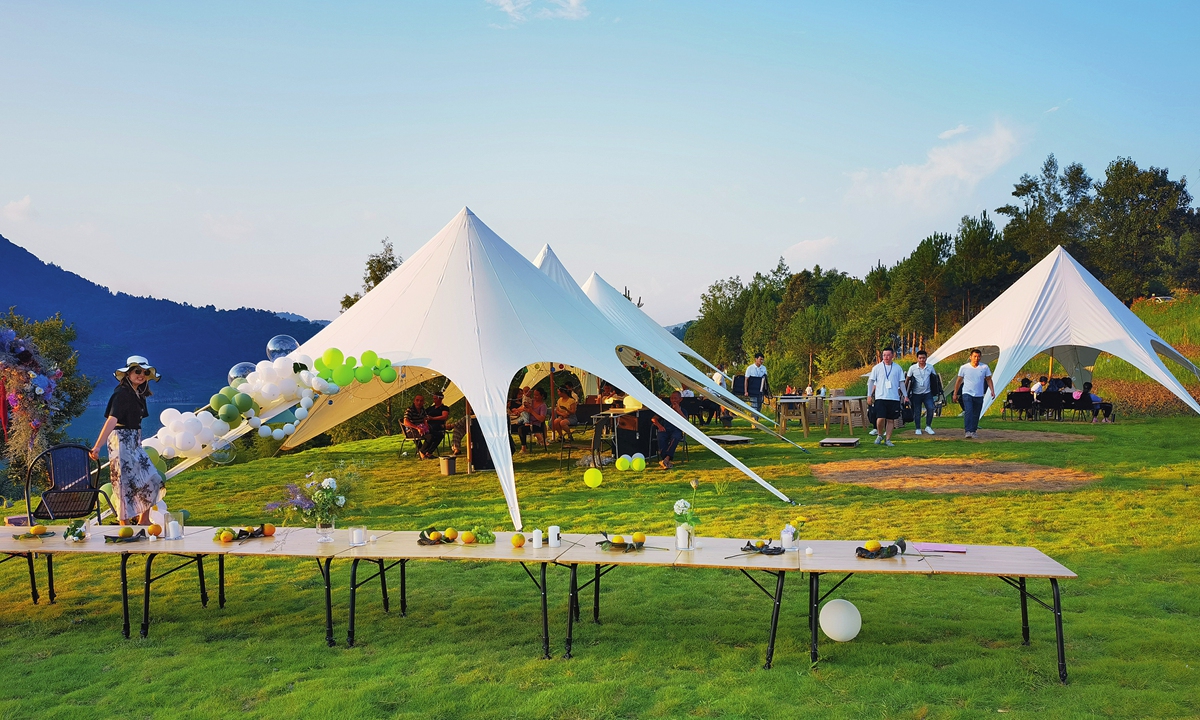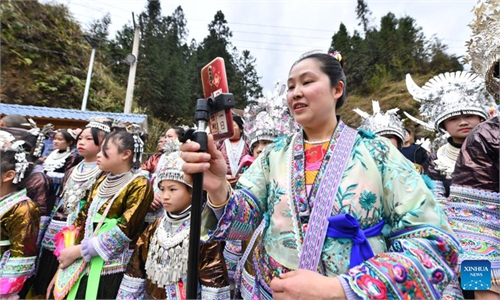Editor's Note:
China Rural Revitalization magazine has published a series of articles on the rapid development of rural areas in China with new transformations. The articles reflect the arduous efforts of rural revitalization across China, which is an important and genuine solution to China's rural economic development. In the future, articles selected from this series will be published.

A view of a wild camping base in Qiaotou town, Shizhu Tujia autonomous county Photo: Courtesy of China Rural Revitalization magazine
Shizhu Tujia autonomous county in Southwest China's Chongqing is located in the Wuling Mountains, which run from Chongqing and Southwest China's Guizhou Province to Central China's Hunan Province. The autonomous county was one of the key areas for national poverty alleviation and development.
At the beginning of 2013, the per capita annual net income of farmers in the county was less than 6,000 yuan ($828.1), and poverty had made people in this small county deep in the Wuling Mountains full of urgent aspirations for getting rid of poverty and living a better life.
Chinese President Xi Jinping first put forward the concept of "targeted poverty alleviation" while visiting a then impoverished village in Hunan during an inspection tour of the province in 2013. The village is also nestled in the Wuling Mountains.
In November 2015, in a speech delivered at a conference on poverty alleviation and development, Xi said that "eliminating poverty, improving living standards, and achieving common prosperity are the basic requirements of socialism."
The remarks have led to renewed efforts, from local officials to residents, to ramp up poverty alleviation and development work in Shizhu county, and to achieve rural revitalization.
Characteristic industry
To uncover the root causes of underdevelopment and advise on solutions, Xi pushed on unabated with inspection tours, visiting some of the poorest places in China, including Huaxi village in Shizhu county in April 2019.
In recent years, the development of sealwort, a kind of traditional Chinese herb, has become a key local industry to promote the rural revitalization.
The average yield of sealwort reaches more than 3,000 kilograms per mu (0.067 hectares) and the market price of 7 yuan per kilogram makes it five times more profitable to grow than traditional food crops. As Huaxi village has a suitable altitude and the right climate conditions, local farmers have been busy cultivating sealwort, backed up by policy support.
In 2018, the village launched a sealwort demonstration base construction project, with a supporting land transfer subsidy policy and an interest-free bank loan, in order to solve the financial problems related to enterprise growth and industrial development. At the same time, local authorities set up an industrial technology guidance system to provide technical support.
In 2023, the 220 mu base in Huaxi village was able to produce up to 3,000 kilograms per mu, with an output value of nearly 9.2 million yuan.
The "sealwort era" has led Shizhu county into a golden age of industrial development. The county has also formed a Chinese herbal medicine processing industry cluster with a 310,000 mu Chinese herbal medicine planting base focusing on sealwort and coptis, another traditional Chinese medical herb.

A couple harvest sealworts in their own sealwort planting field in Shizhu Tujia autonomous county in Southwest China's Chongqing. Photo: Courtesy of China Rural Revitalization magazine
New tourism format
Through the deep adjustment of the structure of the agricultural industry, farmers in Shizhu increased their average income from 400 yuan to more than 2,500 yuan per mu. But in order to achieve long-term stability and wealth, relying only on the development of agriculture is not enough, so the county set its sights on rural tourism.
Qiaotou town has become a key part of the county's efforts to develop the tourism sector, with its advantages of having a good geographic location, multiple ecotourism resources and a rich historical and cultural heritage.
When exploring the best way to achieve a stable homestay business, Ma Hongxing, director of the Rural Revitalization Administration in Shizhu, found a new format: providing personalized and differentiated services to visitors.
Qiaotou rolled out several development plans for the homestay industry, setting up 58 compounds with three major clusters with different themes. For instance, in a wild luxury camping base in a tourism cluster named Binhu Recreation Town, local residents have built 25 lakeside lodgings, with small yards, forest tents and other types of rooms, as well as a landscape-viewing platform, footpaths, water slides and other amusement projects.
This base can receive more than 500 visitors per day, and has an average annual operating income of more than 10 million yuan. The continuous influx of tourists naturally generates demand for supporting services such as food, accommodation and transportation, which brings employment and entrepreneurial opportunities for local villagers.
Since 2023, the base has employed more than 40 residents, with a per capita annual income of 36,000 yuan.
In 2023, the homestay sector in Qiaotou received a total of 55,000 passenger trips, with tourism revenue exceeding more than 45 million yuan. This led to an average annual income increase of 50,000 yuan for participating villagers.
"Over the years, the county's industrial development has played a key role in rural revitalization and boosted the spirit of the townspeople," said Zhang Hua, Party chief of Shizhu county.
"We will continue to promote comprehensive rural revitalization, so that our countryside will become a new rural area with strong industries, a beautiful environment and rich farmers."



